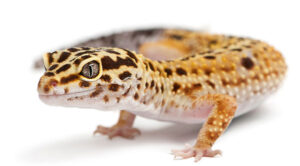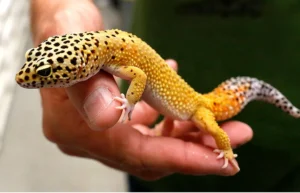Leopard geckos, popularly known for their captivating appearance and low-maintenance care requirements, possess a unique defensive mechanism known as “Leopard Gecko Tail Drop.” This intriguing phenomenon serves as a remarkable adaptation in the reptilian world, allowing these small and enchanting creatures to escape potential threats in the wild.
The Leopard Gecko Tail Drop, also known as autotomy, is a remarkable defense mechanism exhibited by leopard geckos in response to perceived threats or stress. This distinctive behavior involves the intentional detachment of the gecko’s tail, allowing it to escape from potential predators or dangerous situations.
The process is a natural and adaptive response, enabling these small reptiles to prioritize survival in the face of adversity. Also, the tail drop occurs at a designated fracture point, where the gecko’s tail is specifically designed to break away easily.
While the tail is detached, it continues to wriggle and twitch, diverting the attention of the predator and providing a crucial distraction. Meanwhile, the leopard gecko swiftly makes its escape, leaving the detached tail behind.
Importance of the tail in Leopard Geckos

The tail of a leopard gecko serves various important functions, making it a crucial and versatile aspect of their anatomy. Here are some key aspects highlighting the importance of the tail in leopard geckos:
- Storage of Energy Reserves: Leopard geckos are known for their ability to store fat in their tails. This serves as an energy reserve that helps sustain them during periods of food scarcity or when they are unable to feed regularly. A plump and healthy tail is often an indicator of a well-nourished gecko.
- Balancing and Stability: The tail plays a significant role in maintaining balance and stability for leopard geckos. This is particularly important during movements, climbing, and hunting. The tail acts as a counterbalance, allowing them to navigate their environment with precision.
- Communication and Social Interactions: Leopard geckos use their tails for communication with other geckos. Tail waving and other tail movements can convey various messages, including signaling readiness for mating or establishing dominance. The tail serves as a non-verbal means of interaction within their social structure.
- Defense Mechanism: As discussed earlier, the tail is a crucial component of the leopard gecko’s defense mechanism. The ability to drop their tails (autotomy) provides a means of escape from predators, offering the gecko a chance to survive and potentially regenerate a new tail.
- Regeneration: Leopard geckos possess the remarkable ability to regenerate their tails, although the regenerated tail may not be an exact replica of the original. This regenerative capability ensures that the gecko can continue to benefit from the functions of the tail even after a loss due to predation or other threats.
Understanding the multifaceted role of the tail in leopard geckos emphasizes its significance to their overall well-being, survival, and interactions within their ecosystem.



